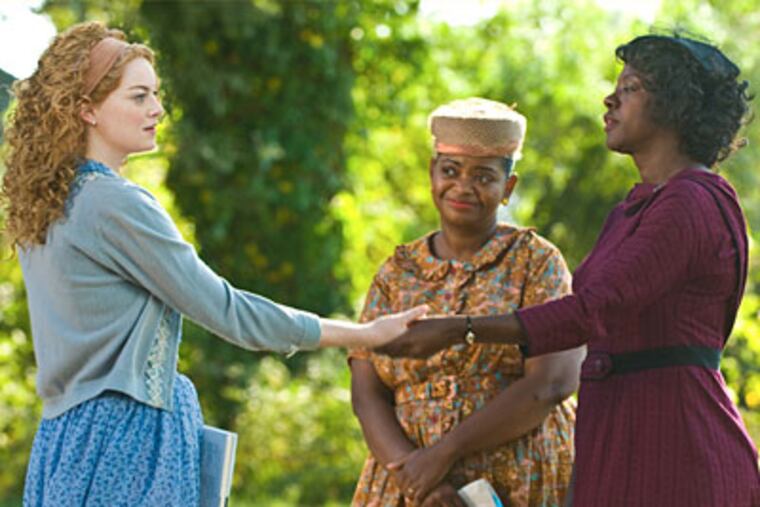“The Help”: Black housekeepers, white employers in ’62 Mississippi
Like Kathryn Stockett's best-seller on which it is based, The Help wastes no time in ticking off the uncivil wrongs that in some quarters passed for equality at the dawn of the civil-rights era.

Like Kathryn Stockett's best-seller on which it is based, The Help wastes no time in ticking off the uncivil wrongs that in some quarters passed for equality at the dawn of the civil-rights era.
For instance, the practice of separate toilet accommodations for blacks, which precipitates the film's action. Some white employers believed that the women who raised their babies, washed their laundry, and prepared their meals would, by sharing the privy, contaminate their families.
It would be easy to regard the movie by Tate Taylor, who adapted the book and directed, as a nostalgic portrait of black dignity in the face of such casual bigotry. Easier still, to dismiss it as the work of a white filmmaker who with one hand slaps himself in the face for the sins of his grandmother and with the other pats himself on the back for his expiation of those sins.
But The Help, set in 1962 Mississippi, is more complex and compassionate and nuanced than that. Like its characters, it has its faults. But overall, it is a movie of imaginative sympathy that gets into the skin of its characters, into their hearts, and, ultimately, into ours.
From Viola Davis and Octavia Spencer as domestics, to Bryce Dallas Howard and Jessica Chastain as their employers, to Emma Stone as an idealist who encourages "the help" to share their stories for an oral history she's collecting, the performances are soul-stirring and hope-raising. (An oral history of black domestics in 1962? Not bloody likely. The Help is better viewed as an emotionally accurate story than a historically accurate one.)
The action takes place in Jackson, Miss., nearly a decade after the constitutionality of separate-but-equal education has been overturned. Still, Hilly (Howard), helmet-coiffed leader of the Junior League, initiates a "sanitary campaign" to encourage members to install separate toilets for the housekeepers.
Aibileen (Davis, in the screen role that her fans have been waiting for) delivers an emotionally devastating and triumphant performance as the ramrod-spined granddaughter of a house slave carrying on the family business. "Raising white babies is what I do," she tells the idealist writer, Skeeter, crisply. "I learned that I can make babies proud of themselves." And she also learned to conceal her own pride.
Skeeter's question - "Did you ever dream of being anything else?" - encourages Aibileen to slowly reveal her shattered dreams and dare to build new ones. Look at how Davis uses her body. When first we see Aibileen, her muscles and essence are contracted. When she recognizes her rigidity is an emotional armor she no longer needs, there is a release and expansion of muscle and spirit that infuses the movie.
As in the novel, Aibileen is the frame of the story. Because of Taylor's choices and Davis' formidable presence, Aibileen also emerges as the principal figure in this group portrait of women at the cusp of social transformation.
If Davis is the soul of the enterprise, Octavia Spencer as Minny, Aibileen's short-fused and outspoken best friend, is the funny bone. Along with Sissy Spacek, as the impish mother of the Junior League dictator Hilly (the coolly intimidating Howard), Spencer provides the levity to complement Davis' gravity.
As Skeeter, Stone functions as a sounding board. Her questions help Aibileen and Minny to tell and hear their own stories, help Skeeter see herself and Southern traditions from another perspective. Stone, a playful and antic actress, puts the brakes on here. Except for one volatile scene with Allison Janney as her mother, it is not her best work. But she gets the job done.
Himself an actor, Taylor is focused more on the performances than on cinematic storytelling. He has a good cinematographer in Stephen Goldblatt, who distills the heat and humidity of the Mississippi locations. He has a most evocative costume designer in Sharen Davis, who subtly contrasts the floral, bubble-skirted dresses of the Junior Leaguers with the tailored, dove-gray maids' uniforms. And he gets added uplift from Thomas Newman's optimistic score.
The artist's job, said surrealist painter Paul Klee, is to make the invisible visible. By making central the backstories and experiences of marginalized women, that is precisely what The Help achieves.